
Putrajaya, officially the Federal Territory of Putrajaya, is the administrative centre of Malaysia. The seat of the federal government of Malaysia was moved in 1999 from Kuala Lumpur to Putrajaya because of overcrowding and congestion, whilst the seat of the judiciary of Malaysia was later moved to Putrajaya in 2003. Kuala Lumpur remains as Malaysia's national capital city per the constitution and is still the seat of the head of state and the national legislature, as well as being the country's commercial and financial centre.

The KLIA Ekspres is an express airport rail link servicing the Kuala Lumpur International Airport (KLIA) in Malaysia. It runs from KL Sentral, the main railway station of Kuala Lumpur to KLIA's Terminal 1 and Terminal 2 stations. The line is one of the two services on the Express Rail Link (ERL) system, sharing the same tracks as the KLIA Transit. The KLIA Transit stops at all stations along the line, whereas the KLIA Ekspres runs as a direct non-stop express service between KL Sentral and KLIA Terminal 1 and 2. It is operated by Express Rail Link Sdn. Bhd. (ERL).

Kuala Lumpur Sentral Station is a transit-oriented development that houses the main railway station of Kuala Lumpur, the capital of Malaysia. Opened on 16 April 2001, KL Sentral replaced the old Kuala Lumpur railway station as the city's main inter-city railway station. KL Sentral is the largest railway station in Malaysia, and also in Southeast Asia from 2001 to 2021, before Krung Thep Aphiwat Central Terminal in Bangkok, Thailand was completed.

Sultan Abdul Aziz Shah Airport also known as Subang SkyPark, — formerly Subang International Airport/Kuala Lumpur International Airport, often called Subang Airport — is an airport located in Subang, Petaling District, Selangor, Malaysia. Serving as the main airport for Kuala Lumpur from 1965 to 1998, replacing the former Sungai Besi Airport, before being succeeded by the newer Kuala Lumpur International Airport in Sepang.

The ERL KLIA Transit is a commuter rail service which serves as an airport rail link to the Kuala Lumpur International Airport (KLIA) in Malaysia. It runs from KL Sentral, the main railway station of Kuala Lumpur to KLIA's Terminal 1 and Terminal 2. The line is one of the two services on the Express Rail Link (ERL) system, sharing the same tracks as the KLIA Ekspres. KLIA Transit stops at all stations along the line, whereas KLIA Ekspres runs an express, non-stop service between KL Sentral and the airport. The line is operated by Express Rail Link Sdn. Bhd. (ERL).

The Express Rail Link Sdn Bhd is a company that owns and operates the airport rail link of the same name that connects the Kuala Lumpur International Airport (KLIA) with the Kuala Lumpur Sentral transportation hub, 57 kilometres apart. The company operates two different train services:

UDA Holdings Berhad is a Malaysian holding company. It served to launch and oversee urban development projects related to business, industry, and housing. It was also tasked with developing urban infrastructure. After undergoing a couple of status changes, it now exists as UDA Holdings Berhad, a publicly listed company.
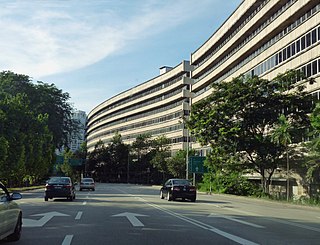
Pusat Bandar Damansara is a township in the Segambut constituency of Kuala Lumpur, Malaysia. The original buildings making up the township were constructed between 1981 and 1984, and were demolished in 2016 for new development.

The People's Plaza is a planned mixed-use skyscraper complex in Kuala Lumpur, Malaysia initiated during the 1990s. However the project, which had already commenced construction, stalled due to the 1997 Asian financial crisis. Attempts to revive the project have come and gone, but no progress has been made, and the construction site remains deserted as of 2025.

Bandar Tasik Selatan is a township in Sungai Besi, Kuala Lumpur, Malaysia. It was established in 1991.
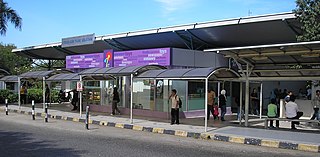
Bandar Tasik Selatan station (BTS) is a major Malaysian interchange station located next to and named after Bandar Tasik Selatan, in Kuala Lumpur. The station serves as both a stop and an interchange for the KTM Komuter's Seremban Line, KTM ETS, the LRT Sri Petaling Line, and the Express Rail Link's KLIA Transit trains. BTS is integrated with the Terminal Bersepadu Selatan bus hub (TBS). BTS and TBS are developed as an intermodal transportation hub.
Transport in Greater Kuala Lumpur includes a road network, a railway network, airports, and other modes of public transport. Greater Kuala Lumpur is conterminous with the Klang Valley, an urban conglomeration consisting of the city of Kuala Lumpur, as well as surrounding towns and cities in the state of Selangor. The Klang Valley has Malaysia's largest airport, the Kuala Lumpur International Airport (KLIA), as well as the country's largest intermodal transport hub and railway station, Kuala Lumpur Sentral.

Gombak LRT station is a light rapid transit (LRT) station in the Gombak District, Selangor, Malaysia. It is the northern terminus of the LRT Kelana Jaya Line.
Kampung Malaysia is a small village in southern Kuala Lumpur, Malaysia.
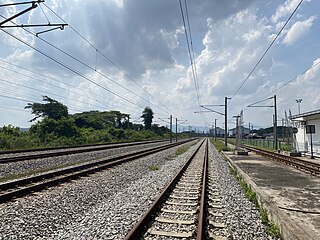
The KTM West Coast railway line runs from Padang Besar close to the Malaysia–Thailand border in Perlis to the Woodlands Train Checkpoint in Singapore. It is called the West Coast railway line because it serves the West Coast states of Peninsular Malaysia. The line is owned and used entirely by Keretapi Tanah Melayu (KTM).

2011 in Malaysia is the 54th anniversary of Malaysia's independence.

2012 in Malaysia is Malaysia's 55th anniversary of Malaysia's independence.

The Urban Transformation Centre (UTC) (Malay: Pusat Transformasi Bandar) is a public amenities centre located at some state capitals and urban areas in Malaysia. The rural counterpart of UTC is Rural Transformation Center(RTC). UTC can be found in the tallest building by state in Malaysia, such as City Plaza Tower in Kedah, KOMTAR Tower in Penang.
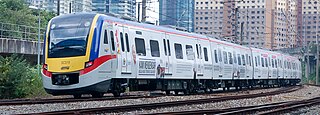
The KTM Batu Caves–Pulau Sebang Line, formerly known as the Seremban Line is one of the three KTM Komuter Central Sector lines provided by Keretapi Tanah Melayu. Its electric trains run between Batu Caves and Pulau Sebang/Tampin. Prior to 15 December 2015, the northern terminus of this line was Rawang.
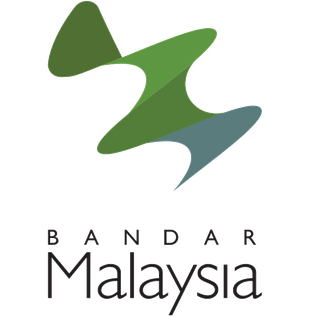
Bandar Malaysia was a proposed mixed-use transit-oriented development located in Kuala Lumpur, Malaysia. This project was to be built at the current Sungai Besi Air Base site over 20 years. It was also planned as a central transport hub connecting high-speed rail to Singapore, Mass Rapid Transit, KTM Komuter, Express Rail Link, and 12 other highways with an estimated gross development value (GDV) of over RM140 billion.


















